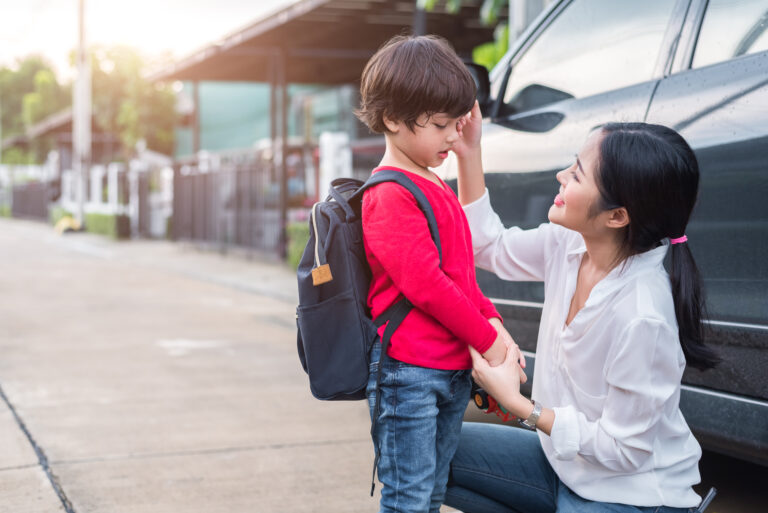Throughout my journey as an early childhood educator, I’ve encountered many little ones experiencing separation anxiety. It’s a natural part of childhood development, yet seeing children struggle with it never gets easier. Over the years, I’ve gathered a toolbox of strategies that help ease this anxiety, ensuring a smoother transition for children as they begin their journey in early learning centres.
Understanding Separation Anxiety
It’s crucial to start with a solid understanding of what separation anxiety is and why it occurs.
Recognizing the Signs
In my work, I’ve seen that separation anxiety can manifest in various ways, from tears and tantrums to clinginess or even silence. Recognizing these signs has been key to addressing each child’s needs effectively.
The Roots of Separation Anxiety
From what I’ve experienced, separation anxiety stems from a fear of the unknown and a strong attachment to caregivers. It’s a normal part of development, indicating strong bonds at home, which we aim to mirror in the childcare environment.
When does Separation Anxiety Start?
I’ve noticed specific times when children are more prone to experience these feelings of longing and unease:
Around 6 to 8 months: many infants face their first major separation as they join daycare, perhaps when I return to work. At this stage, they become keenly aware of my absence, showing signs of distress among unfamiliar faces.
By the time they hit 18 to 24 months: toddlers are far more clued into their surroundings. They see me as their rock – the one who meets their essential needs. The thought of being without me can spark a sense of unease.
As they approach 4 to 5 years: the anticipation of starting ‘big school’ looms large. The unknowns of this new adventure can make them visibly anxious, often expressed through their emotions.
It’s crucial to remember, this phase of separation anxiety is a normal part of growing up for toddlers and infants, with many outgrowing it by the age of 3.
As kids grow into their teenage years, while anxiety might still surface, it’s less about missing their parents and more tied to other challenges – the pressures of school, navigating friendships, and the rollercoaster of adolescence.
Building Trust and Security
Creating a sense of safety and trust within the centre is crucial for easing anxiety.
Consistent Routines
I’ve found that consistency is comforting. Establishing a predictable routine from day one helps children understand what to expect, reducing anxiety over the unknown.
A Warm Welcome
In my journey in childcare, making each child feel individually welcomed and valued has been my secret weapon. A personalized greeting or a favorite activity ready at drop-off can turn anxious mornings into moments of joy.
Strategies for Easing Separation
There are several hands-on strategies I’ve employed to help children adjust to time away from their caregivers.
Gradual Introduction
I’ve personally used a gradual introduction process, where caregivers stay in the centre for increasing intervals over several days. This technique allows children to acclimate to the new environment with the comfort of a familiar presence nearby.
Comfort Objects
Allowing children to bring a comfort object from home, like a stuffed animal or a blanket, has been a simple yet effective way to ease separation anxiety. It’s a piece of home they can hold onto throughout the day.
Engaging Activities
Diving straight into engaging activities has been a great distraction from goodbyes. I’ve seen children’s anxiety diminish as their curiosity and excitement take over when presented with a fun, interactive task as soon as they arrive.
Supporting Through Emotional Learning
Helping children understand and express their emotions is a fundamental part of managing separation anxiety.
Emotional Literacy
In my work, I’ve gathered that teaching children to name and understand their feelings helps them manage anxiety better. We use stories, puppet play, and art to explore emotions and coping strategies.
Reassurance and Encouragement
I’ve tried to provide constant reassurance and encouragement, affirming that it’s okay to miss their caregivers but also that the early learning centre is a safe place. This reinforcement helps build their confidence and sense of security.
Reflection and Adaptation
Reflecting on what works and remaining adaptable is essential as each child is unique.
Observing Individual Needs
Every child’s experience with separation anxiety is different. In my years of working, I’ve learned the importance of observing each child closely and tailoring approaches to meet their individual needs.
Flexibility in Approach
I’ve found that being flexible and willing to adjust strategies is crucial. What works for one child may not work for another, and being open to change has been vital in finding the best way to support each child.
Final Thoughts
In my years of working with children, managing separation anxiety has always been a delicate balance of empathy, patience, and creativity.
By understanding the roots of anxiety, building a secure environment, employing strategic interventions, and focusing on emotional learning, we can significantly ease the transition for children facing separation anxiety in early learning centres.
It’s about creating a bridge from the familiar to the new, ensuring that children feel safe, understood, and excited to embark on their educational journey.
Remember, the goal is not just to manage separation anxiety but to transform it into an opportunity for growth, resilience, and independence.












